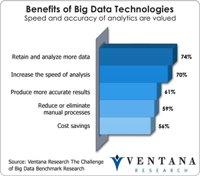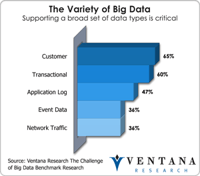Big data has become a big deal as the technology industry has invested tens of billions of dollars to create the next generation of databases and data processing. After the accompanying flood of new categories and marketing terminology from vendors, most in the IT community are now beginning to understand the potential of big data. Ventana Research thoroughly covered the evolving state of the big data and information optimization sector in 2014 and will continue this research in 2015 and...
Read More
Topics:
Big Data,
MapR,
Predictive Analytics,
Sales Performance,
SAP,
Supply Chain Performance,
Human Capital,
Marketing,
Mulesoft,
Paxata,
SnapLogic,
Splunk,
Customer Performance,
Operational Performance,
Business Analytics,
Business Intelligence,
Business Performance,
Cloud Computing,
Cloudera,
Financial Performance,
Hortonworks,
IBM,
Informatica,
Information Management,
Operational Intelligence,
Oracle,
Datawatch,
Dell Boomi,
Information Optimization,
Savi,
Sumo Logic,
Tamr,
Trifacta,
Strata+Hadoop
When organizations need to optimize their business processes and improve operations and decisions, the often speak of having the right information at the right time, but don’t always make that a priority. This information optimization is often thought to be expensive and time-consuming, especially with advent of big data and disparate data sources across cloud and on-premises environments, as I have articulated. Datawatch can help business get to information of any variety or volume at any time...
Read More
Topics:
Big Data,
MapR,
QlikView,
Cloud Computing,
Information Management,
Uncategorized,
Datawatch,
Information Optimization
The big-data landscape just got a little more interesting with the release of EMC’s Pivotal HD distribution of Hadoop. Pivotal HD takes Apache Hadoop and extends it with a data loader and command center capabilities to configure, deploy, monitor and manage Hadoop. Pivotal HD, from EMC’s Pivotal Labs division, integrates with Greenplum Database, a massively parallel processing (MPP) database from EMC’s Greenplum division, and uses HDFS as the storage technology. The combination should help sites...
Read More
Topics:
EMC,
MapR,
HAWQ,
HDFS,
Pivotal HD,
Business Analytics,
Business Intelligence,
Cloud Computing,
Cloudera,
Hortonworks,
Information Applications,
Information Management,
Location Intelligence,
Cirro,
Hive,
Tableau Software,
Strata+Hadoop
LucidWorks addresses the growing volume of information now being stored in the enterprise and in big data with two products aimed at the enterprise with search technology. Though you may not be familiar with LucidWorks (previously known as Lucid Imagination), the company has for many years contributed to Apache Lucene, an open source search project, and commercialized and supported for it for business.
Read More
Topics:
Big Data,
MapR,
Sales Performance,
IT Performance,
Operational Performance,
Business Analytics,
Business Intelligence,
Business Performance,
Cloud Computing,
Cloudera,
Customer & Contact Center,
Hortonworks,
Information Applications,
Information Management,
Operational Intelligence,
Search,
Strata+Hadoop
As volumes of data grow in organizations, so do the number of deployments of Hadoop, and as Hadoop becomes widespread, more organizations demand data analysis, ease of use and visualization of large data sets. In our benchmark research on Hadoop, 88 percent of organizations said analyzing Hadoop data is important, and in our research on business analytics 89 percent said it is important to make it simpler to provide analytics and metrics to all users who need them. As my colleague Mark Smith...
Read More
Topics:
Big Data,
Datameer,
MapR,
Operational Performance,
Business Analytics,
Business Intelligence,
Business Performance,
Cloudera,
Customer & Contact Center,
Hortonworks,
IBM,
Information Applications,
Operational Intelligence,
Visualization,
Data Discovery,
Strata+Hadoop
Cloudera’s recent Hadoop World 2011 event confirmed that the world of big data is getting even bigger. As I wrote of last year’s event, Hadoop, the open source large-scale data processing technology, has gone mainstream. And while 75% of the audience attended this year for the first time and so may not have realized the breadth of Hadoop’s acceptance, statistics announced in the opening keynote show widespread use of it. Mike Olson, Cloudera CEO, reported that the event was sold out, with 1,400...
Read More
Topics:
Big Data,
Datameer,
MapR,
Sales Performance,
Social Media,
Supply Chain Performance,
Operational Performance,
Business Analytics,
Business Intelligence,
Business Performance,
Cloudera,
Customer & Contact Center,
Financial Performance,
Hortonworks,
Informatica HParser,
Karmasphere,
NetApp,
Workforce Performance,
Strata+Hadoop















